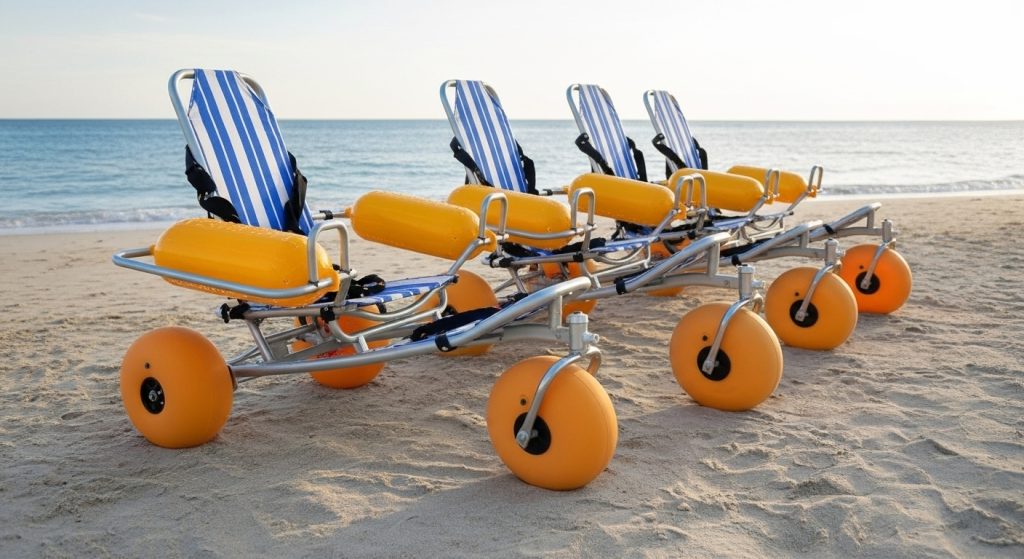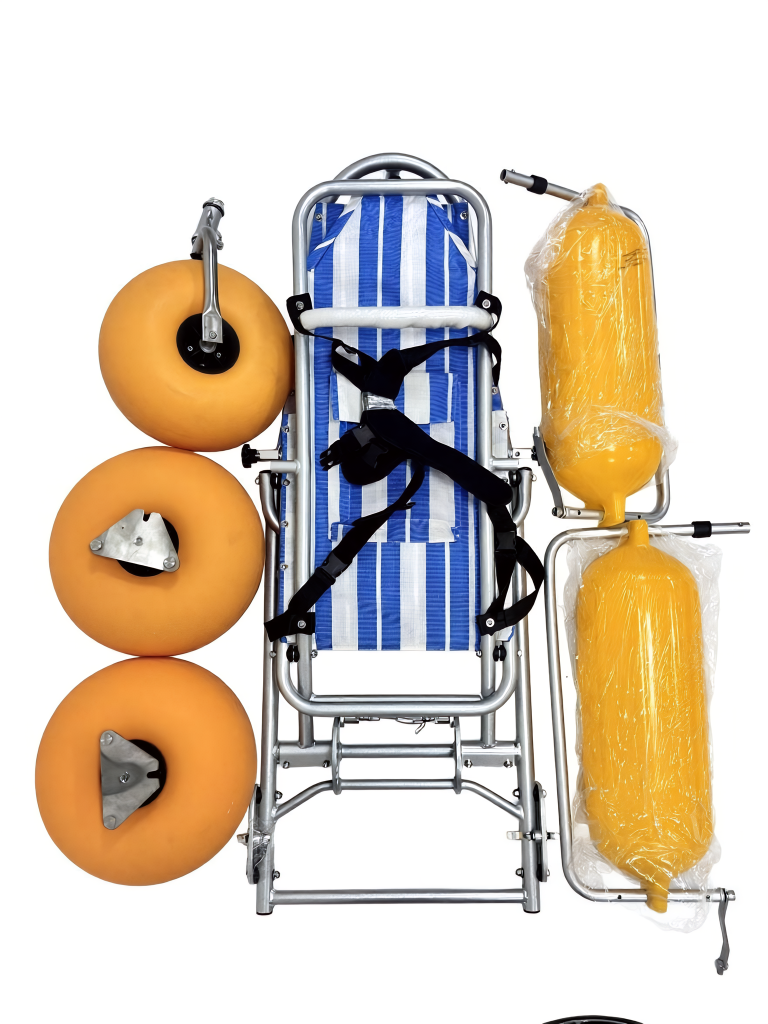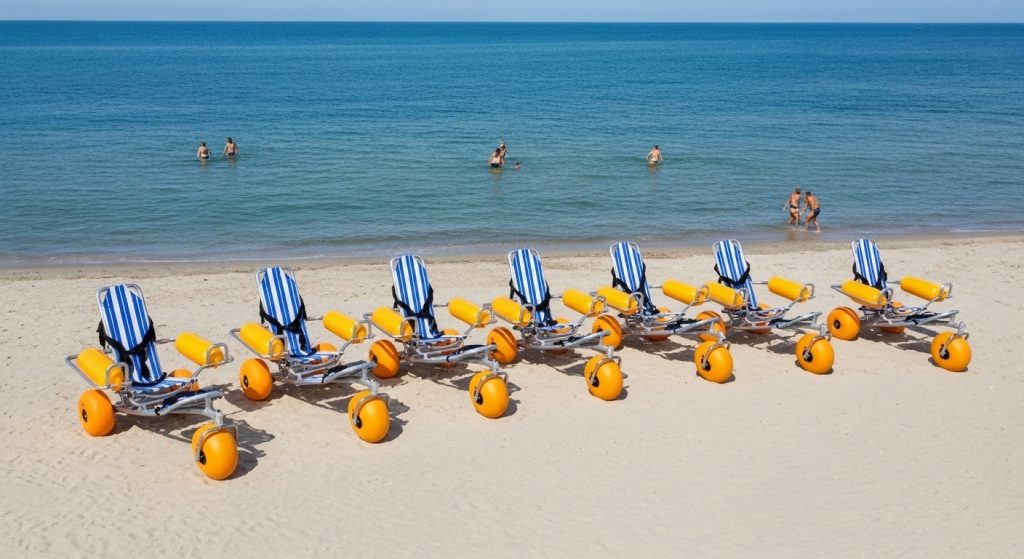Imagine the quintessential beach scene: the sun casting a brilliant sheen on cerulean waves, the gentle susurrus of the surf, the laughter of families echoing along the shore. For most, this littoral paradise is the very definition of escape. But what if that same golden sand, the very foundation of this idyllic setting, became an impassable barrier? An inexorable line drawn between you and the water’s revitalizing embrace. Millions experience this exact dichotomy—present at the party but unable to truly join in. It’s a silent frustration, a compromise that feels anything but fair.
Yet, a quiet revolution is underway, powered by an elegantly simple yet profoundly transformative piece of engineering. This isn’t just about a new type of chair; it’s about dismantling barriers, one buoyant wheel at a time. We’re about to delve into the ingenious mechanics and heartfelt impact of floating beach wheelchairs, a device that is single-handedly rewriting the rules of seaside accessibility. Prepare to see the coastline in an entirely new light.
Sun, Sand, and… Stuck? Why a Perfect Beach Day Isn’t a Given for Everyone

For individuals with disabilities or those facing mobility challenges, the beach often represents a beautiful paradox. It’s a place of freedom and relaxation that is physically restrictive. The very elements that make a beach magical—the soft, shifting sand and the endless expanse of water—are formidable obstacles for a standard wheelchair. The wheels dig in, progress halts, and the dream of feeling the cool surf on your skin remains just that: a dream viewed from a distant boardwalk or a hot parking lot.
This isn’t a niche problem. It affects elderly visitors, people recovering from injury, and anyone with a permanent mobility impairment. The result is often a feeling of exclusion. While friends and family run into the waves, you’re left on the sidelines, a spectator to the joy rather than a participant. This experience can lead to frustration and disappointment, turning what should be a restorative trip into a reminder of limitations. The lack of seaside access is a significant barrier, preventing a full, barrier-free beach experience for countless people.
So, What’s the Big Deal? Here’s How Floating Beach Wheelchairs are Changing the Game
Enter the floating beach wheelchair. Also known as an amphibious wheelchair or water wheelchair, this piece of specialized mobility devices is a masterclass in inclusive design. It’s engineered not just to tolerate the beach environment, but to conquer it. This isn’t merely a beach access chair ; it’s a key that unlocks the entire coastal experience, from the parking lot, across the sand, and directly into the water.
These chairs are dismantling long-standing barriers, transforming coastal areas from inaccessible landscapes into welcoming playgrounds. For the first time, many people are able to experience the simple, profound joy of floating in the ocean alongside their loved ones. It’s a game-changer for accessible tourism and a powerful tool for creating truly inclusive communities.

The “Before” Picture: The All-Too-Common Reality of Being Sidelined at the Seaside
Before the widespread availability of these chairs, the options for a wheelchair user at the beach were grim.
- The Boardwalk Perch: Many were relegated to watching the fun from afar on a wooden boardwalk or paved path, separated from the main event.
- The Risky Push: A well-meaning but often exhausting effort by family and friends to drag or push a standard wheelchair through the sand. This is physically demanding for everyone and offers a bumpy, uncomfortable ride for the user.
- The Damaged Equipment: Sand and saltwater are disastrous for the delicate bearings and metal components of a standard wheelchair. A single beach trip can cause significant
damage to standard wheelchairsfrom rust and abrasion, leading to expensive repairs. The financial risk often made the trip not worth the potential cost.
This reality meant that for many, a “beach day” was a compromised activity, tinged with a sense of being left out. The psychological weight of these attitudinal barriers and physical obstacles often outweighed the potential for enjoyment.
Let’s Pop the Hood: Deconstructing the Magic of a Floating Beach Wheelchair
What makes a floating beach chair so effective? It’s not magic, but brilliant engineering focused on two key challenges: sand and water. These chairs, like the popular Mobi-Chair or WaterWheels models, are built from the ground up for the harsh harsh saltwater environments of the shoreline.
Those Big, Balloon-Like Wheels? Here’s Why They’re a Sand-Conquering Secret Weapon
The most striking feature of any all-terrain wheelchair designed for the beach is its wheels. Instead of thin, high-pressure tires that slice into soft sand, these chairs utilize oversized balloon wheels.
- Low Pressure, High Surface Area: These low-pressure wheels or
flotation tiresdistribute the weight of the chair and its occupant over a much wider surface area. Think of it like the difference between wearing stilettos and snowshoes on fresh snow. The wide tire doesn’t sink, allowing forsmooth mobility across sand.
- Effortless Movement: The result is an incredibly
effortless movementexperience. A gentle push is often all that’s needed to glide over even the softest, driest sand, making it easy for a companion to assist. Some models, likehand cycle beach wheelchairsor amotorized beach wheelchair, even offer a degree of independent propulsion.
- Durable and Puncture-Resistant: The wheels, often a brand like WheelEEZ, are made from durable materials designed to handle
uneven terrainwithout the risk of a puncture ruining the day. This makes them the ultimatesand mobility equipment.
Wait, It Actually Floats?! The Engineering That Makes It All Possible
Here’s where the “floating” part comes in, transforming a manual beach wheelchair into a true aquatic wheelchair.
- Buoyant Materials: The magic of buoyancy is achieved through clever material choices. The armrests and sometimes the wheels themselves are designed as flotation armrests or pontoons. These sealed, air-filled components are what allow the chair to float once it enters the water.
- Corrosion-Resistant Frame: To withstand saltwater, the frames are not made of standard steel. Instead, manufacturers use
corrosion-resistant materialslike a lightweight aluminum frame, stainless steel parts, or high-grade PVC construction. This ensures thedurable beach wheelchairhas a long lifespan, even with regular exposure to the ocean.
- Stability and Safety: Safety is paramount. These chairs are engineered with a low center of gravity and an anti-tip design to provide exceptional stability on sand/in water. Many models also include safety harnesses or belts to ensure the user feels secure while floating. The
ergonomic designand options for areclining backrestorpadded seatsensure acomfortable ride.
More Than Just a Chair: The True Freedom of an Accessible Beach Day
The technical marvels of a floating wheelchair are impressive, but their true value lies in the human experience they unlock. This is about more than just mobility; it’s about dignity, inclusion, and the freedom and independence to create cherished memories.
From Spectator to Splash Zone: Rejoining the Family Fun, Right at the Water’s Edge
Imagine the shift: from watching your children or grandchildren build a sandcastle from a distance to being right there beside them, helping to dig the moat. Imagine rolling into the gentle surf, the cool water swirling around you as the waves lap the shore. This is the power of sand-to-surf mobility .
An amphibious wheelchair allows a person to be in the heart of the action. You are no longer on the periphery. This ability to participate fully fosters connection and eliminates the silent segregation that so often occurs at recreational outings. It’s about creating an inclusive experience where no one gets left behind.
The Therapeutic Power of Water: That Incredible Feeling of Weightlessness and Independence
For many people with mobility impairments, the feeling of weightlessness in water is profoundly liberating. Water supports the body, relieving pressure on joints and allowing for a freedom of movement that is impossible on land. The therapeutic benefits of water are well-documented, both for physical and mental well-being.
Floating peacefully in the ocean, feeling the sun on your face and the gentle rock of the waves, is an unforgettable aquatic experience . It’s a moment of pure relaxation on the beach/in water, a sensory delight that restores the spirit. This is the essence of accessible recreation —not just providing access, but enabling a truly joyful and restorative experience.
Hey, Resort and Park Managers! Why Adding These Chairs is a Genius Business Move
For managers of resorts, hotels, and seaside parks , investing in floating beach wheelchairs and other accessibility features isn’t just the right thing to do—it’s a savvy business decision. By embracing inclusive design principles, you open your doors to a massive, underserved, and deeply loyal market.
Tapping Into a Huge, Grateful Market (Hint: It’s Just Good Business)
The market for inclusive travel is enormous. It includes not only the individuals with disabilities themselves but their entire travel party—spouses, children, friends, and relatives who make travel decisions based on the accessibility of a destination.
- Economic Power: This demographic has significant spending power and is actively looking for destinations that cater to their needs.
- Loyalty: When you provide a truly
barrier-free experience, you earn more than a customer; you earn an advocate. Guests who have an amazing, accessible vacation are highly likely to return and to recommend your establishment to others within their community.
- Growing Demographic: With the
aging populationin many countries, the demand for accessible amenities is only going to increase.
By offering a beach wheelchair rental program or, even better, a complimentary use/loan programs , you are making a powerful statement that your business is for everyone.
Becoming an Accessibility Hero: The Unbeatable PR of True Inclusivity
In today’s market, corporate social responsibility matters. Being known as a leader in accessibility provides an unparalleled public relations advantage.
By proactively
improving accessibility, you’re not just complying with regulations like the ADA (Americans with Disabilities Act); you’re building a brand reputation based on care, empathy, and genuine hospitality.
This commitment goes beyond just having a floating dock with ramp. It should be part of a holistic approach to resort accessibility features , which can include:
| Amenity | Description | Impact |
|---|---|---|
| Beach Access Mats | Roll-out portable pathways (like Mobi-Mats) that create a firm surface over the sand. | Allows wheelchair users and those with walkers to get from the boardwalk to the firmer, wet sand near the water. |
| Accessible Rooms | Rooms with wider doorways , roll-in showers , grab bars , and lower sinks . | Ensures the entire stay is comfortable and dignified, not just the time at the beach. |
| Pool Access Lifts | Mechanical lifts that safely transfer a person from their wheelchair into the pool. | Provides safe and independent pool access , another key component of a resort vacation. |
| Staff Training | Staff disability awareness training to ensure employees can assist guests knowledgeably and respectfully. | Creates a welcoming atmosphere and smooths over potential service issues. |
| Zero-Entry Pools | Pools with a sloped entrance, like a beach, eliminating the need for steps or lifts. | The gold standard for inclusive design in aquatic environments. |
“Okay, I’m Sold!” Your Action Plan for Finding a Floating Beach Chair for Your Next Trip
Ready to plan a trip where everyone can enjoy the sand and surf? A little bit of advance planning is all it takes.
Pro Tips for Calling Ahead to Your Hotel, Resort, or Local Park
Don’t just assume these adaptive equipment will be available. Be proactive!
- Check the Website: Look for an “Accessibility” page on the resort or park’s website. They often list
accessible amenitiesthere.
- Call Directly: Speak with the concierge or guest services at a hotel, or the main office at a public park. Don’t be afraid to be specific.
- Ask the Right Questions:
- “Do you offer floating beach wheelchair rentals, or are they complimentary for guests?”
- “What type of chairs do you have? Are they manual or do you have a
motorized beach wheelchair?”
- “Is it possible to make
online reservationsfor a chair to guarantee availability?”
- “Do your
beach access matsgo all the way to the water’s edge?”
- Inquire About Local Services: If the hotel doesn’t have them, ask if they know of local companies like
Sand Helperthat offer delivery services. You can also check withlocal beach authorities/tourism centers.
Your First Time Using a Floating Chair: A Super Simple Guide to What to Expect
Using an amphibious beach wheelchair is straightforward, but here are a few tips:
- Transfers: You will likely need to transfer from your day chair to the beach wheelchair. This often happens at a boardwalk or accessible pathway. Some locations may offer a
transfer boards for sandif needed.
- Assistance is Key: Most
manual beach wheelchairmodels are designed to be pushed by a companion. They are notself-propelled beach chairdesigns.
- Entering the Water: Go slowly. The chair will feel stable as it enters the surf. Once the water is deep enough for the flotation components to engage, you’ll begin to float. The person assisting you should stay with the chair.
- Relax and Enjoy: Once you’re floating, just relax! The chair is designed to be stable. Let the water support you and enjoy the incredible sensation.
Are All Floating Wheelchairs the Same? A Quick Peek at the Different Types You Might See

While they all serve the same core purpose, you might encounter a few different styles of water wheelchairs :
- The Reclining Lounger (e.g., Mobi-Chair): These often feature a more
reclined positionand look like a floating lounge chair. They are excellent forrelaxationand are very stable in the water.
- The Upright Model (e.g., DeBug, WaterWheels): These maintain a more traditional wheelchair seating position. Some, like the Hippocampe water wheelchairs, are known for their sporty design and can be used for
adaptive water sports.
- Collapsible/Portable Models: Some designs, like a
collapsible beach wheelchair, are made foreasy transport/assembly, making them a great option for individuals who want to purchase their ownportable beach wheelchairto bring on trips.
What’s Next? The Future is Bright for Beach Accessibility
The adoption of floating beach wheelchairs is a fantastic step, but it’s part of a broader movement towards universal design in coastal areas. The future holds even more promise:
- Wider Adoption: More
community initiativesand grant-funded programs will bring these chairs to more public beaches, not just high-end resorts.
- Technological Integration: We may see more
electric beach wheelchairmodels with waterproof motors and joystick controls, or integration withmotorized track systemslike Freedom Trax for even greater independence.
- Holistic Design: Urban planners and resort designers are increasingly incorporating accessibility from the very beginning of a project, creating
barrier-free environmentsthat include everything fromaccessible parkingand restrooms toadaptive beach seatingand sensory-friendly play areas.
My Final Take: Let’s Make Every Shoreline a Welcome Mat for Everyone
The floating beach wheelchair is more than just a piece of equipment; it’s a symbol of progress. It represents a shift in thinking—a recognition that public spaces should be for all of the public. It proves that with thoughtful design and a commitment to inclusion, we can overcome barriers that once seemed insurmountable.
The goal is simple: to make every shoreline, from the grandest resort to the local seaside park , a welcome mat for everyone, regardless of mobility. So next time you plan a beach trip, ask about accessibility. Advocate for these changes in your own community. Let’s work together to ensure that the joy of a perfect beach day is no longer a luxury, but a given for all.

